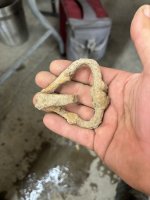heepiepow
Full Member
- Aug 27, 2010
- 248
- 90
- Detector(s) used
- Teknetics Delta 4000
- Primary Interest:
- Metal Detecting
I'd been wondering why I've found new things at places, down to square inches, that I'd previously detected. And while the actual answer for me may be (probably) incompetence or ignoring tones or something, artifacts including coins and relics DO actually shift with time....largely because of underground animals. Generally, small animals like earthworms tend to shift things up; while larger animals like moles tend to shift things down due to burrow collapse. Here's a link to a fairly dry paper on this phenomenon of "bioturbation"--biological organisms shifting objects up, down and laterally. It's pretty fascinating, archaeologically and for us detectorists (warning .pdf):
http://alliance.la.asu.edu/rockart/scans/Balek.pdf
Some choice quotes (long, very well-cited article, I recommend reading all of it) [edited to add:for some reason my copy-paste of the paper made a lot of words there have no spaces inbetween. I don't know why, but if you read, just read it as if the authors did include spaces between words, because they did]:
My bold:
So...there may be worth in identifying various small mammal detritus screes as of particular interest (they may toss out small deep, old items smaller than the diameter of the burrow's opening). And in the possibility that a place or 1x1 foot square you found something nice at a decade or two ago might now have a new great find, purely through bioturbation redistributing items. The Earth beneath us doesn't seem static by any means. Little things are moving things around, including coins and other artifacts!
http://alliance.la.asu.edu/rockart/scans/Balek.pdf
Some choice quotes (long, very well-cited article, I recommend reading all of it) [edited to add:for some reason my copy-paste of the paper made a lot of words there have no spaces inbetween. I don't know why, but if you read, just read it as if the authors did include spaces between words, because they did]:
Many studies now link the movement of artifacts and other objects within soilsto biota. In one experiment conducted by Armour-Chelu and Andrews (1994), asingle large, deep-burrowing earthworm (Lumbricus terrestris) was placed in oneof two cylindrical glass jars measuring 30 cm in diameter and 60 cm in height. Bothjars contained soil and small mammal carcasses placed on the soil surface. At theend of 2 years, the mammal bones in the jar containing the single deep-burrowingearthworm had been displaced vertically at least 24 cm and laterally 15 cm. Incontrast, the mammal bones in the jar without an earthworm showed no lateral orvertical displacement.
My bold:
Bocek (1986, 1992) conducted an experiment to ascertain the impact of rodentactivity, mainly the pocket gopher Thomomys bottae, on archaeological materialsat the Jasper Ridge Site in Stanford University’s Biological Reserve, San MateoCounty, California. The site is an unplowed, grass-covered tract that contains anEarly Late Horizon component dating to A.D. 900. A 1-by-2 meter test unit that hadbeen excavated in 1981 and subsequently backfilled with screened dirt that containedno materials larger than 0.6 cm in diameter was re-excavated in 1988. There-excavated fill contained 8% of the total cultural and rock material between 0.6cm and 1.8 cm in diameter and 15% of material between 1.8 cm and 3.5 cm indiameter, all recovered by screening. The introduction of this new material intothe test unit was interpreted by Bocek as due to lateral transport by rodents fromthe surrounding unexcavated portions of the site. It was estimated that at this rateit would take only 88 years for the entire test unit to be refilled with cultural material.
Burial of most, if not all, artifacts in stable upland soils developed in pre-Holocenesediments in nonfeature contexts, is due to vertical movement of the artifactin response to normal biologic activity, namely, burrowing and mounding by earthworms,ants, and other fauna, and by tree-uprooting. As long as soil biota continueto exist and create voids through which artifacts can fall, and as long as lifeformscontinue to mix the soil matrix through preferential ejection of materials fromdepth onto the surface in the form of burrow mounds, or through tree uprooting,artifacts will be displaced.
Soil fauna burrowing and mounding activity and tree-uprooting can affect artifactdisposition in several ways. Through burrowing and mounding, artifacts can becomedisplaced and sorted vertically by size thereby destroying stratigraphic integrity.Generally, artifacts (stones) whose diameters are less than the diameter ofthe burrows of soil fauna may be translocated upward and deposited in mounds.For example, studies indicate that crayfish (Robertson and Johnson, 2001), pocketgophers (Johnson, 1989), and mole-rats (Mbenza et al., 1989) will shift rock fractionssmaller than the diameter of the burrows to the surface. I have observedconcentrations of fist-sized cobbles in back-dirt piles formed outside the mouthsof burrows of unidentified large mammals. These cobble-rich piles stood in markedcontrast to the surrounding undisturbed soil with no cobbles at the surface.
So...there may be worth in identifying various small mammal detritus screes as of particular interest (they may toss out small deep, old items smaller than the diameter of the burrow's opening). And in the possibility that a place or 1x1 foot square you found something nice at a decade or two ago might now have a new great find, purely through bioturbation redistributing items. The Earth beneath us doesn't seem static by any means. Little things are moving things around, including coins and other artifacts!
Last edited:




